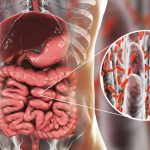The Endocannabinoid System: Interactions with Gut Flora and the GI System
JAKE F. FELICE, ND, LMP
Addressing clinical features of the endocannabinoid system and its modulation offers a new opportunity for clinicians to explore complementary and alternative medicine (CAM) therapies.1,2 The variable nature of the endocannabinoid system (ECS) dictates a patient-centered dosing paradigm, necessitating an education-based approach to patient care that is consistent with naturopathic principles. In addition to cannabinoids, ECS stimulation may be mediated by the use of low-toxicity compounds to which the ECS responds favorably, including physical medicine, probiotics, diet and lifestyle interventions, mind-body dynamics, and more.3-5 The information presented in this paper highlights the multi-faceted interactions of the ECS with the gastrointestinal (GI) system and supports the feasibility of new and existing pharmacologic and CAM therapies for GI health and disease.3 Large opportunities exist for ongoing research into the effects of this dynamic network-based system.6
Broad-Spectrum Effects of the ECS
The endocannabinoid system is extensively distributed throughout the gut and corresponding lymphatics.1,2 Currently, cannabis and cannabinoids are being used to treat a wide range of GI conditions, ranging from emesis and motility issues to abdominal pain and inflammatory states.2 In the digestive tract, the ECS exerts effects on food intake,2 intestinal inflammation,2 cell proliferation,2 gastroprotection,2 secretion,7 ion transport,2 pain and visceral sensations,8 epithelial integrity,9 and the gut microbiota.10 The ECS is involved in all aspects of energy balance and food intake in the body, including both hedonic and homeostatic aspects within the GI tract.11
ECS-signaling pathways mediate multiple critical functions in human health and disease. Evolutionarily, the 600 million-year-old ECS emerged as a harm-reduction system, maintaining a constantly adaptive receptor system functioning as a biological scanning system that detects biochemical alterations intracellularly as well as in the extracellular matrix.12 The ECS has both general effects and organ-specific effects.2
The ECS is a biologic communication and protection system that developed as early life forms evolved from single-celled organisms into multi-cellular organisms.13 As such, the ECS is simultaneously involved in an immense number of physiologic processes. These include reproduction, embryogenesis, mood and emotional responses, cognition, plasticity, motor function, growth and development, learning/memory, pain signaling, the interpretation and processing of nociceptive signals, and more.14,15
ECS signaling controls a variety of GI functions, including inflammation and gut permeability, GI motility, gut-derived hunger signaling, and dynamic interactions with gut flora.10 And accumulating evidence suggests a critical role for ECS dysfunction in the development GI disorders.9 The ECS represents the most dense of all receptor systems in the human CNS, underscoring its essential role in both biologic communication and homeostasis.16
The ECS affects every biological oscillator or pacemaker cell investigated, including circadian rhythms, rhythmical variations in blood pressure (known as Traube-Hering waves), peristalsis slow waves, and both EKG and EEG rhythms.17 In humans, ECS coordination is integral to both health promotion and disease prevention. As a stress-reduction system, the ECS responds positively not only to cannabinoids, but also to diet, lifestyle, and physical medicine interventions, and it offers a substantial venue for discovering efficacies in therapeutic applications for CAM protocols.3
The ECS consists of cannabinoid (CB) receptors CB1 and CB2, endogenous ligands known as endocannabinoids (including their transport mechanisms), and endocannabinoid-metabolizing enzymes. As mentioned, this system functions as a self-regulating harm-reduction system, profoundly influencing multiple physiologic processes in the human body and in almost all other animals. Due to its enormous nature, a full discussion of the ECS is beyond the scope of this paper.
ECS Mechanisms Within the GI System
Stimulation of CB1 receptors acts neuronally to reduce emesis and promote hunger and eating.18 Additionally, CB1 receptors transiently reduce lower-esophageal sphincter tone, reduce gut motility, pain and diarrhea, and may downregulate mechanisms of GERD, including gastric acid secretions.18 Evidence points to CB1, CB2, and transient receptor potential vanilloid-1 (TRPV1) receptor involvement in gut inflammation, as well as inflammation’s effects on intestinal motility and secretion.18 Interestingly, endocannabinoid levels in the gut and brain vary in response to different states of satiety, emesis, diarrhea, and inflammation, underscoring the ECS’s role as an adaptive response system.19
Levels of satiety, as well as the gut peptides, ghrelin and cholecystokinin, affect CB1 receptor expression in vagal afferent communication between the gut and the CNS.19 In turn, CB1, CB2, and TRPV-1 receptors in the brainstem regulate vagal efferent control of gut function.19
ECS & GI Protection
In several animal models, cannabinoids have been shown to attenuate oxidative injury from cerebral, hepatic, and myocardial ischemia in remarkable ways.20 In one such study, an ultra-low dose of tetrahydrocannabinol (THC) reduced oxidative, apoptotic, and inflammatory liver injury induced by ischemia and reperfusion.21 The authors speculated that THC might serve as a target for therapeutic intervention during liver resection, liver transplantation, and trauma.
Cannabinoids provide protection to gastric mucosa via antisecretory, anti-inflammatory, antioxidant, and vasodilatory properties.22 In a mouse model of cannabis dependence, allosteric modulation of CB1 receptors blocked NSAID-induced gastric inflammation and GI hemorrhages.23 Interestingly, in mice, delta-9-THC was found to reduce gastric irritation from alcohol and NSAIDs.24 In addition to their antineoplastic effects, cannabinoids may have a significant impact on the reversal of hepatic fibrosis.25
Energy Balance & the ECS
Despite increased caloric intake, regular cannabis users overall show significantly reduced rates of body mass index and obesity.26 One reason for this is that a long-lasting downregulation of CB1 in cannabis users increases metabolic rate and reduces energy storage. Obesity is characterized by chronic systemic inflammation, which can be triggered by the intestinal leakage of bacterial lipopolysaccharides (LPS).27 The ECS, gut flora, and the gut-brain axis regulate energy balance, including the development of obesity-associated inflammation, through indirect and direct actions.27 In a human study, cannabis consumption protected against liver steatosis in psychotic patients by modulating the weight gain associated with antipsychotic treatment; these effects were thought to be partly due to reductions in lipid and glycemic metabolic disturbances.28
The ECS, Gut Flora, & GI/Systemic Disorders
The human gut flora plays an essential role in the education and effectiveness of the human immune system; at the same time, bacterial dysbiosis contributes to metabolic and autoimmune disorders that have inflammatory components, including multiple sclerosis, rheumatoid arthritis, and inflammatory bowel disease (IBD).29 Gut microbes influence ECS tone, and LPS released during dysbiosis stimulate potent responses from the ECS.30 Interestingly, atherosclerosis has been linked to altered ECS tone. Animal studies have shown that cross-communication between gut flora and the ECS may contribute to atherogenesis by increasing LPS plasma levels. Antibiotic-associated gut flora alterations upregulate and modify the functioning CB2 receptors in an anti-inflammatory fashion, which suggests a therapeutic role for endocannabinoids in cardiovascular disease prevention.30
In a propensity-matched cohort study, IBD patients who used cannabis showed a decreased prevalence of colorectal cancer (0.3% vs 1.2%, p<0.001), a lower need for parenteral nutrition, and less anemia as compared to non-cannabis-users.31 The cannabis cohort also experienced a lower frequency of post-operative infections, and had shorter hospital stays along with lower hospital charges as compared to non-cannabis patients ($28 956 vs $35 180, p<0.001).
In a study of mucosal biopsies in irritable bowel syndrome (IBS) patients vs controls, the ECS was shown in the IBS samples to compensate for visceral pain via immune-modifying mechnisms.32 Remarkably, Lactobacillus spp use ECS signaling to communicate with the body’s intestinal epithelial cells and mediate analgesic perception in the gut.33 That the ECS can influence visceral perception suggests novel ECS-based approaches to the treatment of abdominal pain and IBS.
Summary
The ECS and related bioactive lipids participate in multiple physiologic processes that contribute to the body’s homeostasis via GI and neuroimmune regulation.29 Ineffective gut function due to dysbiosis and LPS-induced endotoxemia is associated with chronic, systemic low-grade inflammation.30 The ECS plays a vital role in the control of both intestinal permeability27 and inflammation.30 Considerable evidence demonstrates that a healthy ECS provides a significantly positive prebiotic and probiotic influence.30 Rodent research has suggested that by preventing microbial dysbiosis, cannabinoids may help prevent autoimmune processes and inhibit neuroinflammation while at the same time promoting healthy gut bacteria.34
References:
- Di Marzo V, Piscitelli F. Gut feelings about the endocannabinoid system. Neurogastroenterol Motil. 2011;23(5):391-398.
- Izzo AA, Sharkey KA. Cannabinoids and the gut: New developments and emerging concepts. Pharmacol Ther. 2010;126(1):21-38.
- McPartland JM, Guy GW, di Marzo V. Care and feeding of the endocannabinoid system: A systematic review of potential clinical interventions that upregulate the endocannabinoid system. PLoS One. 2014;9(3): e89566.
- McPartland JM. Expression of the endocannabinoid system in fibroblasts and myofascial tissues. J Bodyw Mov Ther. 2008;12(2):169-182.
- McPartland JM. The Endocannabinoid System: An Osteopathic Perspective. J Am Osteopath Assoc. 2015;108(10):586-600.
- Hopkins AL. Network pharmacology: The next paradigm in drug discovery. Nat Chem Biol. 2008;4(11):682-690.
- Schicho R, Storr M. Topical and systemic cannabidiol improves trinitrobenzene sulfonic acid colitis in mice. Pharmacology. 2012;89(3-4):149-155.
- Brusberg M, Arvidsson S, Kang D, et al. CB1 receptors mediate the analgesic effects of cannabinoids on colorectal distension-induced visceral pain in rodents. J Neurosci. 2009;29(5):1554-1564.
- Smid SD. Gastrointestinal endocannabinoid system: Multifaceted roles in the healthy and inflamed intestine. Clin Exp Pharmacol Physiol. 2008;35(11):1383-1387.
- DiPatrizio NV. Endocannabinoids in the Gut. Cannabis Cannabinoid Res. 2016;1(1):67-77.
- Di Marzo V, Ligresti A, Cristino L. The endocannabinoid system as a link between homoeostatic and hedonic pathways involved in energy balance regulation. Int J Obes (Lond). 2009;33 Suppl 2:S18-S24.
- McPartland JM, Matias I, di Marzo V, Glass M. Evolutionary origins of the endocannabinoid system. Gene. 2006;370:64-74.
- McPartland JM, Agraval J, Gleeson D, et al. Cannabinoid receptors in invertebrates. J Evol Biol. 2006;19(2):366-373.
- Corroon J, Felice JF. The endocannabinoid system and its modulation by cannabidiol (CBD). Altern Ther Health Med. 2019;25(S2):6-14.
- Lutgendorff F, Akkermans L, Söderholm J. The Role of Microbiota and Probiotics in Stress-Induced Gastrointestinal Damage. Curr Mol Med. 2008;8(4):282-298.
- Kendall DA, Yudowski GA. Cannabinoid Receptors in the Central Nervous System: Their Signaling and Roles in Disease. Front Cell Neurosci. 2017;10:294.
- Pacher P, Bátkai S, Kunos G. The endocannabinoid system as an emerging target of pharmacotherapy. Pharmacol Rev. 2006;58(3):389-462.
- Sanger GJ. Endocannabinoids and the gastrointestinal tract: What are the key questions? Br J Pharmacol. 2007;152(5):663-670.
- Storr MA, Sharkey KA. The endocannabinoid system and gut-brain signalling. Curr Opin Pharmacol. 2007;7(6):575-582.
- Horváth B, Magid L, Mukhopadhyay P, et al. A new cannabinoid CB2 receptor agonist HU-910 attenuates oxidative stress, inflammation and cell death associated with hepatic ischaemia/reperfusion injury. Br J Pharmacol. 2012;165(8):2462-2478.
- Hochhauser E, Lahat E, Sultan M, et al. Ultra Low Dose Delta 9-Tetrahydrocannabinol Protects Mouse Liver from Ischemia Reperfusion Injury. Cell Physiol Biochem. 2015;36(5):1971-1981.
- Abdel-Salam O. Gastric acid inhibitory and gastric protective effects of Cannabis and cannabinoids. Asian Pac J Trop Med. 2016;9(5):413-419.
- Trexler KR, Eckard ML, Kinsey SG. CB1 positive allosteric modulation attenuates Δ9-THC withdrawal and NSAID-induced gastric inflammation. Pharmacol Biochem Behav. 2019;177:27-33.
- Kinsey SG, Cole EC. Acute Δ9-tetrahydrocannabinol blocks gastric hemorrhages induced by the nonsteroidal anti-inflammatory drug diclofenac sodium in mice. Eur J Pharmacol. 2013;715(1-3):111-116.
- Izzo AA, Camilleri M. Emerging role of cannabinoids in gastrointestinal and liver diseases: Basic and clinical aspects. Gut. 2008;57(8):1140-1155.
- Clark TM, Jones JM, Hall AG, et al. Theoretical Explanation for Reduced Body Mass Index and Obesity Rates in Cannabis Users. Cannabis Cannabinoid Res. 2018;3(1):259-271.
- Cluny NL, Reimer RA, Sharkey KA. Cannabinoid signalling regulates inflammation and energy balance: The importance of the brain-gut axis. Brain Behav Immun. 2012;26(5):691-698.
- Vázquez-Bourgon J, Ortiz-García de la Foz V, Suarez-Pereira I, et al. Cannabis consumption and non-alcoholic fatty liver disease. A three years longitudinal study in first episode non-affective psychosis patients. Prog Neuropsychopharmacol Biol Psychiatry. 2019;95:109677.
- Mestre L, Carrillo-Salinas FJ, Mecha M, et al. Gut microbiota, cannabinoid system and neuroimmune interactions: New perspectives in multiple sclerosis. Biochem Pharmacol. 2018;157:51-66.
- Moludi J, Alizadeh M, Lotfi Yagin N, et al. New insights on atherosclerosis: A cross-talk between endocannabinoid systems with gut microbiota. J Cardiovasc Thorac Res. 2018;10(3):129-137.
- Desai R, Patel U, Goyal H, et al. In-hospital outcomes of inflammatory bowel disease in cannabis users: a nationwide propensity-matched analysis in the United States. Ann Transl Med. 2019;7(12):252-252.
- Dothel G, Chang L, Shih W, et al. µ‐opioid receptor, β‐endorphin, and cannabinoid receptor‐2 are increased in the colonic mucosa of irritable bowel syndrome patients. Neurogastroenterol Motil. 2019;31(11):d13688.
- Rousseaux C, Thuru X, Gelot A, et al. Lactobacillus acidophilus modulates intestinal pain and induces opioid and cannabinoid receptors. Nat Med. 2007;13(1):35-37.
- Al-Ghezi ZZ, Busbee PB, Alghetaa H, et al. Combination of cannabinoids, delta-9-tetrahydrocannabinol (THC) and cannabidiol (CBD), mitigates experimental autoimmune encephalomyelitis (EAE) by altering the gut microbiome. Brain Behav Immun. 2019;82:25-35.

Jake F. Felice, ND, LMP is a cannabis author, clinician, and educator whose vision is to advance the science and practical application of medical cannabis for medical and recreational markets around the world. Dr Felice provides world class cannabis education experiences by speaking authentically about hemp and cannabis. He consults with healthcare providers and the general public. His Category-1 CME courses for doctors, nurses, and pharmacists have now been translated into 4 languages. Dr Felice is the founder of Cannabis Matrix Consulting, LLC, and he maintains a regular cannabis blog at drjakefelice.com.










